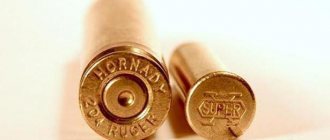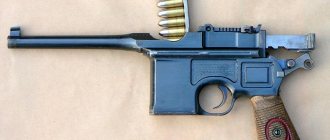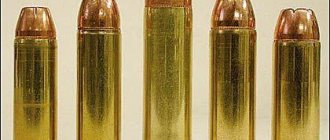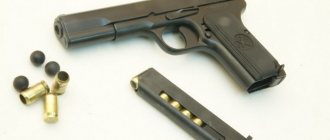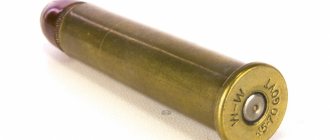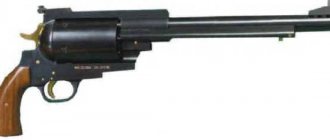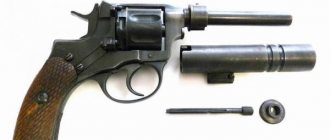Encyclopedia of weapons
.17 HMR / .17 Hornady Magnum Rimfire cartridge
Tactical and technical characteristics of .17 HMR (4.3×27 RF): Caliber, mm - .17 HMR (4.3×27 RF) Cartridge length, mm - 34.3 Case length, mm - 26.93 Bullet leading part diameter, mm - 4.30 Case neck diameter, mm — 4.81 Case neck diameter, mm — 4.88 Case shoulder diameter, mm — 6.08 Case base diameter, mm — 6.10 Case flange diameter, mm — 7.34 Flange thickness cartridge case, mm - 1.18 Bullet weight, g - 1.1-1.3 Initial bullet speed, m/s - 720-780 Bullet energy, J - 330-340
In 2002, the famous American arms company Hornady created a small-caliber rimfire cartridge .17 HMR (.17 Hornady Magnum Rimfire).
The new ammunition was based on a cartridge case from the widely used .22 WMR rimfire cartridge, the barrel of which was compressed to a caliber of 0.172 inches (4.37 mm). As a result, with the same powder charge as the .22 WMR, the bullet of the new cartridge received a much higher initial velocity.
However, the .17 HMR bullet was unusually small and light. In order to obtain high accuracy at a low price for equipment for the production of bullets, it was decided to make the head of the bullet (nose) from plastic, which is cheaper to process while maintaining ballistic characteristics similar to a solid bimetallic shell.
The .17 Hornady Magnum Rimfire cartridge has a bottle-shaped case and is standardly equipped with a 1.1 gram bullet, the muzzle velocity of which reaches 780 m/s, and the muzzle energy is 340 J. At such a high speed, the bullet has a very flat trajectory and high accuracy.
However, the plastic nose of the bullet makes the already light bullet lighter, which negatively affects its energy retention at distances over 200 meters. As a result, a bullet with an initial speed of 710-780 m/s from rifle barrels provides a flat trajectory at a distance of up to 150 meters, after which the trajectory begins to decrease due to a drop in the speed and energy of the bullet.
After its introduction to the American market, the .17 Hornady Magnum Rimfire cartridge became widely popular. According to a number of experts, it significantly expanded the capabilities of small-caliber rimfire cartridges. A wide range of weapons, primarily long-barreled ones, immediately began to be produced under it. Since the cartridge turned out to be very light, this allowed the weight of the rifle with a match barrel to be no more than 2.5 kg.
In addition to rifles chambered for .17 HMR, the production of short-barreled weapons was established. The Brazilian revolver TAURUS New-Tracker M17 was a good example of such a weapon. The six-inch barrel accelerates the bullet to 530 m/s, which allows you to confidently hit varmint targets (usually small field rodents).
The .17 Hornady Magnum Rimfire cartridge is suited to its primary purpose—sport shooting. Despite the small caliber, the .17 HMR is significantly superior to other ammunition of this class in terms of accuracy of fire and flatness of the bullet trajectory, which increases its value in sports shooting.
It is also suitable for shooting rodents (rats, American prairie dogs, etc.), but for larger game its power is completely insufficient. In addition, when shooting outdoors, the low weight of the bullet, which is easily deflected even by a weak wind, has an impact.
The disadvantage of the cartridge compared to other ammunition of this class is the higher price, which is important for sports shooting, when the consumption of cartridges is sometimes calculated in the hundreds. In addition to Hornady, the production of cartridges was launched by many manufacturers, including such well-known ones as Winchester, Remington, etc.
The .17 Hornady Magnum Rimfire cartridge, with its unusual characteristics for a rimfire cartridge, immediately gained considerable popularity. In the wake of its success, Hornady created another ammunition of the same caliber in 2004 - the .17 Hornady Mach 2, but based on the .22 Long Rifle Stinger cartridge.
The .17 HMR cartridge is known as: .17 Hornady Magnum Rimfire / .17 HMR / 4.3×27 RF / XCR 04 027 BBR 020.
‹ Cartridge .17 HM2 Up Cartridge .17 Remington ›
.17 HMR / .17 Hornady Magnum Rimfire cartridge
| .17 HMR |
The .17 HMR cartridge is known as: .17 Hornady Magnum Rimfire / .17 HMR / 4.3×27 RF / XCR 04 027 BBR 020.
.17 HMR
In 2002, the famous American arms company Hornady created a small-caliber rimfire cartridge .17 HMR (.17 Hornady Magnum Rimfire).
The new ammunition was based on a cartridge case from the widely used .22 WMR rimfire cartridge, the barrel of which was compressed to a caliber of 0.172 inches (4.37 mm). As a result, with the same powder charge as the .22 WMR, the bullet of the new cartridge received a much higher initial velocity.
However, the .17 HMR bullet was unusually small and light.
In order to obtain high accuracy at a low price for equipment for the production of bullets, it was decided to make the head of the bullet (nose) from plastic, which is cheaper to process while maintaining ballistic characteristics similar to a solid bimetallic shell. .17 HMR
The .17 Hornady Magnum Rimfire cartridge has a bottle-shaped case and is standardly equipped with a 1.1 gram bullet, the muzzle velocity of which reaches 780 m/s, and the muzzle energy is 340 J. At such a high speed, the bullet has a very flat trajectory and high accuracy. However, the plastic nose of the bullet makes the already light bullet lighter, which negatively affects its energy retention at distances over 200 meters. As a result, a bullet with an initial speed of 710-780 m/s from rifle barrels provides a flat trajectory at a distance of up to 150 meters, after which the trajectory begins to decrease due to a drop in the speed and energy of the bullet.
After its introduction to the American market, the .17 Hornady Magnum Rimfire cartridge became widely popular. According to a number of experts, it significantly expanded the capabilities of small-caliber rimfire cartridges. A wide range of weapons, primarily long-barreled ones, immediately began to be produced under it. Since the cartridge turned out to be very light, this allowed the weight of the rifle with a match barrel to be no more than 2.5 kg.
In addition to rifles chambered for .17 HMR, the production of short-barreled weapons was established.
The Brazilian revolver TAURUS New-Tracker M17 was a good example of such a weapon. The six-inch barrel accelerates the bullet to 530 m/s, which allows you to confidently hit varmint targets (usually small field rodents). .17 HMR
The .17 Hornady Magnum Rimfire cartridge is suited to its primary purpose - sport shooting. Despite the small caliber, the .17 HMR is significantly superior to other ammunition of this class in terms of accuracy of fire and flatness of the bullet trajectory, which increases its value in sports shooting.
It is also suitable for shooting rodents (rats, American prairie dogs, etc.), but for larger game its power is completely insufficient. In addition, when shooting outdoors, the low weight of the bullet, which is easily deflected even by light winds, can have an effect.
.22 WMR, .17 HMR, .22 LR Stinger, .17 HM 2 (from left to right)
The disadvantage of the cartridge compared to other ammunition of this class is the higher price, which is important for sports shooting, when the consumption of cartridges is sometimes calculated in the hundreds. In the USA, the cost of a pack of .17 HMR is 50 pieces. in the late 2000s it was $16-18.
In addition to Hornady, the production of cartridges was launched by many manufacturers, including such well-known ones as Winchester, Remington, etc.
The .17 Hornady Magnum Rimfire cartridge, with its unusual characteristics for a rimfire cartridge, immediately gained considerable popularity. In the wake of its success, Hornady created another ammunition of the same caliber in 2004 - the .17 Hornady Mach 2, but based on the .22 Long Rifle Stinger cartridge.
| .17 HMR |
Availability[edit]
The .17 HMR ballistic cap cartridge (left) compared to the .22 Long Rifle cartridge (right)
The .17 HMR comes with bullets that weigh 15.5 grains (1.00 g), 17 grains (1.1 g), and 20 grains (1.3 g) and comes in designs such as plastic-tipped bullets , hollow tips, soft tips and FMJs. Terminal ballistics of lightweight expanding bullets are limited to .17 HMR for small game animals and varmints. .17 HMR ammunition is less common and more expensive than .22 rimfire, but that is changing as the popularity of .17 HMR rifles gains momentum. [6]
.17 HMR Hollow Point Ammo Box
More and more companies are offering .17 HMR ammunition. CCI Ammunition loads all CCI, Federal Cartridge, Hornady and Remington brands of .17 HMR ammunition. However, the ammunition is loaded with different bullets with different characteristics. [7] Ammunition is also available from Winchester, PMC and Sellier & Bellot.
Examples of bolt-action or lever-action rifles that are chambered for (or have variants chambered for) 17.HMR include the Armscor M1700, CZ 452, Ruger Model 96, Savage 93, and Steyr Scout.
Citing safety concerns when using the cartridge in semi-automatic firearms, Remington issued a product safety warning and recall notice. [8] [9]
Links[edit]
- PMC ammunition website
- "Hornady .17 HMR Page". Archived from the original on September 27, 2007. Retrieved September 25, 2007.
- ^ a b ".17 Hornady Magnum Rimfire". Archived from the original on September 29, 2007. Retrieved September 25, 2007.
- "Magnum Rimfire Comparison: .17 HMR, 5mm Rem. RF Mag, and .22 WMR". Archived from the original on September 29, 2007. Retrieved September 25, 2007.
- Centurion resumed production of the 5mm RMR in 2007.
- ↑
Borchardt Rifle Corp. sells parts to convert Ruger revolvers to .17 HMR. - "Ammunition Summary: .17 HMR". Archived from the original on September 16, 2009. Retrieved September 25, 2007.
- ".17 Safety Issues with HMR Semi-Automatic Firearms". Archived from the original on 2012-02-25. Retrieved November 21, 2009.
- "Safety Warning and Recall Notice". Archived from the original on February 12, 2010. Retrieved February 6, 2010.
Pistol cartridges
9x18 PMM PISTOL CARTRIDGE
The lag of domestic military short-barreled weapons from modern Western models, due primarily to the low stopping and penetrating effect of relatively low-power 9x18 cartridges for the Makarov pistol, has led to the need for a radical modernization of pistol ammunition. In the late 1980s, Soviet KBP designers, as a result of modernizing the Makarov pistol in order to increase its power on the basis of the standard PM cartridge (57-N-181 s), created a promising high-pulse pistol cartridge 9 x18 PMM.
In 1991, the Soviet Army adopted the 9-mm PMM pistol designed by R. G. Shigapov and the new “high-impulse” pistol cartridge 9 x18 PMM (57-N-181 cm) with a bullet of increased penetration of a modified configuration (index 7 N16) ( with a sleeve length of 18 mm, the muzzle energy of this cartridge was increased by 1.7 times).
Using a standard 9x18 PM cartridge case, as well as new gunpowder, increasing their weight and using a new bullet design in the PMM cartridge, the designers managed to bring the characteristics of the new ammunition to the level of the 9x19 Parabellum cartridge without a significant increase in pressure and recoil energy. In terms of muzzle energy (494 J), this cartridge is almost equal to the standard 9-mm NATO pistol cartridge. . The maximum pressure of the PMM cartridge increased by 15 percent compared to the PM cartridge. . The initial speed with a steel core increased from 315 to 430 m/s. The 9-mm PMM pistol cartridge has increased bullet penetration and greater stopping power. Its bullet weighing 5.4 g penetrates a 3 mm thick steel sheet or the body of a passenger car at a distance of up to 20 meters, without ricocheting at impact angles of 15–20 degrees. At a distance of up to 10 meters, it ensures the destruction of manpower protected by army-style body armor.
The PMM cartridge is fixed when inserted into the chamber with the front end of the cartridge case into the chamber ledge. For external differences, the PMM bullet with increased penetration has a head part of a bimetallic shell in the form of a truncated cone and the same steel core with a lead jacket. The propellant charge is lacquer gunpowder brand SEN 20/4.85, weight is 0.45 g. The bullet is shell-type, with a steel core made of heat-strengthened steel. To reduce the possibility of ricochets, the conical head of the bullet has a flat shape. By improving the ballistic properties, the initial speed (415–435 m/s) and muzzle energy of the bullet, its penetrating and stopping effect increased. The accuracy of fire at 25 meters is 3.2 cm. However, firing the new ammunition in the standard Makarov pistol was not recommended due to the sharply increased maximum pressure of the powder gases, since the maximum pressure of the new cartridge was 15 percent higher than that of the PM cartridge. That is why the PMM pistol had to strengthen the steel frame and bolt housing.
In 1995, the Instrument Design Bureau (KBP, Tula) developed a new 9-mm armor-piercing bullet PBM for the 9 x18 PMM pistol cartridge (index 7 N25). The PBM semi-jacketed bullet (weight 3.55 g, length 14.9 mm) has a bimetallic jacket, a hardened steel core exposed on top (made of carbon steel U8 A; U10 A with a hardness of more than 60 HRC units, weight 1.8 g, length 14 .6 mm, diameter - 5.0 mm) and an aluminum jacket that fits the core on the sides. The head part of the core in the shape of a truncated cone protrudes 3 mm from the bimetallic shell. To accommodate the long core, a bulge is stamped into the tail of the bullet shell. The low mass of the bullet at a high initial speed (compared to a standard cartridge) made it possible to increase its kinetic energy when meeting an obstacle at distances of up to 25 meters. A bullet from the PBM cartridge penetrates a general-arms protective vest model 6 B5-12 at a distance of 10 meters with a probability of 100 percent (1.25 mm titanium plate and 30 layers of aramid fabric), while the core comes out of the shell and goes deep into the gelatin block simulator to a depth of up to 12 cm (the density of gelatin is approximately equal to the density of the human body), and a 5 mm steel sheet at a distance of 15 meters with a probability of 80 percent. It is also important that the bullet of the 9x18 PBM cartridge (or its core when firing at a protected target) leaves a straight wound channel, does not increase its diameter and does not fragment, which complies with the norms of international humanitarian law. These are truly impressive results, since no other bullet for the Makarov pistol cartridge has shown such high combat characteristics. The propellant charge of gunpowder provides an initial bullet speed of 485–495 m/s, which corresponds to a kinetic energy of 418 J (versus 273 J for a standard bullet), but also significantly increases the recoil impulse.
PMM cartridges have been produced since 1991 only in Russia, in particular the 9-mm armor-piercing PBM cartridge is produced by the Novosibirsk Low-Voltage Equipment Plant. Designed for firing from pistols PMM, "Berdysh", submachine guns "Klin", "Bison-2", which are in service with special forces of the Russian Ministry of Internal Affairs. It is prohibited to use 9 x18 PMM cartridges for firing from weapons designed for 9 x18 PM cartridges, since due to the increased gas pressure (from 120 to 150 MPa), destruction of weapon parts is possible when fired.
Cartridge length, mm — 24.48–25 Case length, mm — 18 Cartridge weight, g — 9.16–9.91 Bullet weight, g — 5.35–5.75 Initial speed, m/s — 410–435 Muzzle energy, J - 494
9x17 K service pistol cartridge
In Russia, the 9 x17 service pistol cartridge has been produced since 1996 by the Tula Cartridge Plant and is known as the 9 x17 mm K. The new Russian pistol cartridge is an exact copy of the widely used 9 x17 Browning Short pistol cartridge. This cartridge was used extremely rarely in military models, but was widely used in police and civilian pistols.
After certification of the 9×17 cartridge in Russia, it was accepted as service ammunition, and a modification of the PM pistol under the designation IZH-71 and a number of pistols and revolvers are produced for it. Russian-made cartridges are weaker than 9x18 PM cartridges due to the lower muzzle velocity of the bullet, which instead of a steel core has a soft lead center and a soft shell clad with tombak (a soft alloy consisting of 90 percent copper and 10 percent zinc). However, despite the insufficient destructive power of the bullet and other above-mentioned disadvantages, this cartridge is one of the most successful pistol cartridges, because the low initial velocity of the bullet, combined with low recoil force, has a positive effect on the constancy of combat and shooting accuracy, and, among other things, reduces the likelihood of ricochet when shooting indoors. In addition, the qualities of the cartridge make it possible to design lightweight and compact weapons for it.
The cartridge is fixed when it is inserted into the chamber with the front end of the cartridge case into the ledge of the chamber. The bullet consists of a brass bimetallic shell and a lead core. The cartridge sleeve is cylindrical in shape with a non-protruding flange; it can be either brass or varnished steel.
Cartridge length, mm — 25 Case length, mm — 17 Cartridge weight, g — 9.13–9.73 Bullet weight, g — 5.9–6.2 Initial speed, m/s — 270–315 Muzzle energy, J — 224
9x19 pistol cartridges
Along with standard 9-mm PM pistol cartridges, at the end of the 1990s, Russia adopted 9x19 Parabellum pistol cartridges, which were new to us but widespread throughout the world. The 9 x19 Parabellum cartridge was used not only in pistols of the same name, but also in many types of automatic small arms. Thanks to its qualities such as sufficient power, combat accuracy and a flat trajectory of the bullet, this cartridge has become the most widely used.
After the end of World War II, the 9x19 pistol cartridge became practically an international ammunition and currently Parabellum cartridges are produced by almost all the leading cartridge companies in the world. In 1965, it was standardized as a NATO pistol cartridge (9 mm NATO) with a bullet weighing 7.45 g and a muzzle velocity of 396 m/s, and since then almost all samples of short-barreled weapons and most submachine guns in the armies of states - members of the North Atlantic bloc are designed to use this particular ammunition.
The use of this cartridge as one of the standard ammunition for military weapons of the Russian army was due to the fact that the 9x18 PM cartridge was powerless against modern means of personal armor protection. During 1994–1995, the Klimov TsNIITOCHMASH designed, developed documentation, manufactured and carried out factory tests of the promising domestic pistol cartridge 9x19 RG 057 (later after adoption standardized as product 7 N21), intended for the 9-mm Yarygin pistol. The new 9x19 cartridge with a bullet of increased penetration, developed by TsNIITOCHMASH designer I. P. Kasyanov based on the decision of a technical meeting on May 19, 1993 on the implementation of the Rook program, was made in the dimensions of the world famous 9x19 Parabellum cartridge, but at the same time exceeded it by the damaging effect of a bullet.
9 x19 pistol cartridges (from left to right): 9 x19.000 Ulyanovsk Mechanical Plant;
9 x19 PSO of the Tula Cartridge Plant; 7 H21; PBP (7 N31); a cartridge with a bullet with reduced ricocheting ability and a lead core. The 7 N21 cartridge is designed to defeat manpower, including those equipped with personal protective equipment. A semi-jacketed bullet of increased penetration with a steel core Pst cartridge 7 N21 (bullet weight 5.3 g) has a bimetallic cup-shell with a core protruding from it in a polyethylene jacket. The head part of the heat-strengthened core (steel 65 G, hardness - 50–60 HRC, weight 3.7 g) has the shape of a truncated cone, with a cylindrical part diameter of 7 mm and a length of 16 mm. The design of the bullet ensured better penetration and increased stopping effect; in addition, thanks to the enhanced powder charge, the bullet has a very high initial speed - up to 460 m/s (muzzle energy - about 550 J) and high penetration - 8-mm steel sheet StZ at a distance of 5 m. The penetration range of body armor Zh-81 - Zh-86-2 is up to 25 meters. The color of the bullet head is black.
In 1997, at the Tula Instrument Design Bureau (KBP), designers V.K. Zelenko, V.M. Korolev and V.A. Volkov, led by A.G. Shipunov and V.P. Gryazev, developed a new 9 x19 armor-piercing cartridge with a bullet of increased penetration for the GSh-18 pistol. During development and factory testing, the cartridge with a very light armor-piercing bullet was called 9 x19 PBP (armour-piercing pistol cartridge); it was subsequently adopted under the designation 7 N31 for service in the Russian army and law enforcement agencies along with the GSh-18 pistol. The cartridge was based on a 9x19 pistol cartridge, and the design of the bullet was based on the design of the PBM bullet. First of all, it was decided to increase the power of the cartridge by increasing the muzzle energy of a bullet with an armor-piercing core, and not by increasing the ballistic impulse. For this purpose, a special armor-piercing bullet with a heat-strengthened steel core in a polyethylene jacket was designed. The lighter bullet had a bimetallic jacket with an exposed core. With the same ballistic impulse of the cartridge as the PM (0.22 kg per second), the initial velocity increased from 315 m/s to 500 m/s. This cartridge could be used without any improvements in standard PM pistols. But the external impact of the bullet has changed quite significantly. If earlier a standard PM bullet from 10 meters penetrated only one and a half millimeters of 10-mm steel sheet, now from this distance the PM pistol pierced a five-mm sheet, which even a standard American military 9-mm pistol could not do from a distance of 0.5 meters. Beretta M 9.
The armor-piercing semi-sheathed bullet of increased penetration of the 7 N31 cartridge (weight 4.15 g) has a bimetallic shell, a heat-strengthened steel core (U7 steel, hardness 60 HRC, weight 2.2 g, length 17.5 mm, diameter - 5.0 mm), protruding from the shell by 4.8 mm, and an aluminum jacket. The head part of the core has the shape of a truncated cone. The 7 N31 bullet with an initial speed of 612 m/s penetrates third-class body armor or an 8 mm thick StZ steel sheet at a distance of 20 meters.
9 x19 cartridge is fixed when chambered by the front end of the cartridge case into the ledge of the chamber. The sleeve is cylindrical with a non-protruding rim (flange), brass, varnished steel or bimetallic with a slight taper (0.1 mm) with a capsule socket for a Berdan (Boxer) capsule. Pistol cartridges produced by the Tula Cartridge Plant have external bullet sealing and an increased (compared to other Russian cartridge factories) thickness of the varnish layer at the barrel of the case.
9x19 pistol cartridges PSO, 7 N21 and 7 N31 are used for firing from Yarygin pistols, GSh-18, PP-90 M1 submachine gun, etc.
Cartridge length, mm — 29.7 Case length, mm — 19 Cartridge weight, g — 11.6–12.3 Bullet weight, g — 7.45–8.1 Initial speed, m/s — 396 Muzzle energy, J — 584
9x21 pistol cartridges
In 1991, the designers of the Central Scientific Research Institute of Precision Engineering (TSNIITOCHMASH) in the city of Klimovsk near Moscow, on the topic of Rook and Design Development "Rook", were given the task of developing a new pistol complex as part of a pistol for the fundamentally new 9-mm pistol cartridge of increased size, which was being developed at that time. power, which in terms of its performance characteristics would be superior to similar weapons being equipped by foreign armies of the most developed countries.
9x21 pistol cartridges (from left to right): SP-10 - with an armor-piercing bullet with a heat-strengthened steel core;
SP-11 (index 7 N28) - with a bullet with a lead core in a bimetallic jacket; SP-12 (index 7 N29) - with a bullet with a steel core; exemplary; educational According to the given tactical and technical requirements, the designer of the institute A. B. Yuryev, together with technologist E. S. Kornilova, under the leadership of I. P. Kasyanov, began to develop a new 9 x21 mm pistol cartridge of increased power RG 052 with a bullet with a high lethal effect. Moreover, it was initially planned that in the future this cartridge would be used to fire not only from a promising pistol, but also from a submachine gun that was already planned at that time. The high penetrating ability of the RG 052 cartridge was achieved due to the original design of the bullet (thus, to increase the penetrating effect of its bullet, a polyethylene jacket was used, and the steel core was exposed at the top of the bullet) and an optimal ballistic solution. The bullet had a very high initial speed - 420 m/s, which ensured a guaranteed defeat of the enemy’s protected manpower at a distance of up to 100 meters, which almost doubled the technical specifications of the GRAU. This was also greatly facilitated by the colossal contribution of the State Research Institute of Chemical Chemical Industry from Kazan, which provided cartridge production with three new types of gunpowder. Such a decision opened up significant opportunities for the entire “ammunition-weapons” complex.
The 9 x21 RG 052 pistol cartridge provided penetration of body armor containing one or two 1.4 mm thick titanium plates and 30 layers of Kevlar at a range of up to 50 meters or a 4 mm thick steel sheet at ranges of up to 30 meters, surpassing domestic and similar pistol cartridges. foreign production in terms of lethal effect by 1.3 and 1.4 times. Improved in 1993 by designer I.P. Kasyanov, the cartridge received the RG0 54 index. In 2000, the FSB and SVR, and a little later the Ministry of Internal Affairs, adopted a new set of small arms, which included: 9-mm pistol SR.1 “Vector” "; 9-mm submachine gun SR.2 “Veresk” and 9 x21 cartridges.
Soon, on the basis of the SR.1 pistol, the designers of TsNIITOCHMASH developed its export version RG 060 (received its own name “Gyurza”). An export modification of the SP cartridge was also designed for it. 10. 9 x21 pistol cartridge SP-10 with a bullet of increased penetration ensured penetration of 5 mm of steel sheet at a distance of 50 meters. In 1996, the cartridge, simultaneously with the Serdyukov SR.1 pistol, was adopted by the Russian FSB and received the official name - the special cartridge SP-10.
The SP-10 (7 N29) cartridge with an increased penetration bullet with a steel core is designed to defeat enemy personnel wearing personal protective equipment and unarmored vehicles. The semi-jacketed bullet of the SP-10 cartridge (weight 6.7 g, diameter 9.0 mm) has a bimetallic shell without a rear cone and belt, a steel heat-strengthened stamped core (hardness 54–58 HRC), protruding from the shell by 3.4 mm and a polyethylene shirt. The head part of the core has the shape of a truncated cone with a top diameter of about 3.0 mm. (The RG 052 bullet, unlike the SP-10 bullet, had a turning core with a tip diameter of 2.0 mm.) This design makes it possible to reduce the energy loss of the armor-piercing core to pierce the bullet shell when it hits an obstacle. Thanks to this, the bullet of the SP-10 cartridge has a high penetrating effect. At ranges of 50 meters, a bullet penetrates a 4-mm steel sheet, and at 100 meters - 2 titanium plates 1.4 mm thick with 30 layers of aramid fabric. Initially, the bullet tip of the SP-10 cartridge was painted black, but currently it is painted red. The packaging cartons for these cartridges are distinctively black.
Development work on the “Rook” theme, which lasted 12 years, ended in 2003 with the creation of three powerful pistol systems that meet all modern requirements and allow solving almost all fire missions assigned to this type of weapon.
On March 21, 2003, by Decree of the Government of the Russian Federation No. 166, 9-mm pistol systems were adopted into service by the Armed Forces of the Russian Federation and the Ministry of Internal Affairs: pistol PYa designed by the Izhevsk Mechanical Plant V. A. Yarygin - chambered for 9 x19 cartridge (index 7 N21) developed by TsNIITOCHMASH; pistol GSh-18, designed by KBP, Tula, V.P. Gryazev and A.G. Shipunov, chambered for 9 x19 cartridge of our own design (index 7 N31) and self-loading pistol SPS, designed by TsNIITOCHMASH, Klimovsk, P.M. Serdyukov, chambered for 9 x21 cartridges ( index 7 N28; 7 N29; 7 BTZ) developed by TsNIITOCHMASH.
The position of automatic parts and components, as well as 7 N21 cartridges of the Yarygin PYa pistol before firing a shot.
The new pistol was originally intended to solve a wide range of tactical tasks. The range of 9 x21 cartridges used for various purposes for the SR.1 pistol has been significantly expanded:
SP-10 (7 N29) - with a bullet with a steel core of increased penetration; SP-11 (7 N28) - with a low-ricochet bullet with a lead core in a bimetallic jacket; SP-12 - with an expansive bullet with a steel core; SP-13 (7 BTZ) - with an armor-piercing tracer bullet.
The design of bullets, their penetrating effect and ballistics also determine the purpose of the cartridges - for shooting at unprotected personnel, SP-11 (7 N28) and SP-12 cartridges are used; to hit targets wearing personal protective equipment located in cars and behind various light obstacles (doors, wooden floors, thin walls) - SP-10 (7 N29) or SP-13 (7 BTZ) cartridges. The cartridge with the SP-11 bullet with a lead core is designed to destroy enemy personnel not protected by personal protective equipment or in protective equipment without metal protective plates, for firing in confined spaces, where the possibility of defeating friendly servicemen from bullet ricochet increases significantly, and for conducting training shooting. The shape of the bullet is similar to that of the 9 x 19 Parabellum cartridge - ogival with a rounded top, without a rear cone or belt. The bullet has a bimetallic jacket and a lead core with a stepped recess of 2.5 mm in the bottom. The muzzle energy of the cartridge is 590 J. The bullet diameter complies with the NATO standard - 9.0 mm. The bullet of the SP-11 cartridge and the cardboard packaging boxes do not have a distinctive color.
The SP-12 cartridge with an expansive bullet with a steel core is designed to engage unprotected enemy personnel protected by personal protective equipment, including those in vehicles and behind light obstacles (doors, wooden floors, thin walls) in confined spaces, where significant the possibility of ricochet increases. The 7 N29 cartridge bullet consists of a heat-strengthened steel core, a polyethylene jacket and a bimetallic shell. The nose of the core protrudes from the shell. This bullet design made it possible to reduce the energy loss of the armor-piercing core to pierce the bullet shell. Thanks to this, the bullet of the 7 N29 cartridge had a high penetrating effect. The tip of the SP-12 cartridge bullet was painted black.
All 9x21 pistol cartridges have the same external dimensions and consist of a bullet, a cartridge case, a propellant charge and an igniter primer. The cartridges are standardized according to the cartridge case and igniter primer. Their difference lies in the design of the bullets. The sleeve is bimetallic, cylindrical in shape with a slight taper (0.2 mm) and two ignition holes for the Berdan primer. The propellant charge is pyroxylin single-channel gunpowder P-45 placed in a cartridge case with increased density. Charge weight - 0.52 g. Capacity of packaging cardboard boxes - 30 rounds.
Development[edit]
Left: 17 HMR, Right: 22 WMR
The .17 HMR cartridge is similar to cartridges developed by specialized rimfire specialists who worked to create a rimfire cartridge with an exceptionally flat trajectory. These wildcatters sought to match the ballistics of the obsolete 5mm Remington Rimfire Magnum cartridge, which was produced from 1970 to 1974 and was, at that time, the fastest rimfire cartridge ever produced. [4] Since 5mm barrels and bullets were virtually unavailable at the time (the 5mm RMR was the last commercial 5mm cartridge until the 2004 release of the .204 Ruger), the commercially available .17 caliber became their choice. . The +0.22 Winchester Magnum Rimfire was the logical parent case rather than the 5mm RMR (with its unique case head size that requires a significantly different bolt and magazine) because it was widely available and it is a much larger and stronger case. than the next largest, the . 22 long rifle. The .17 caliber Wildcats not only matched but far exceeded the 5mm RMR in speed and flat trajectory. The accuracy of these cartridges was also good. However, the 5mm RMR's lower level firing energy is superior to both the .22 WMR and the .17 HMR, so the 5mm rimfire is still potentially useful for wildcat hunters. [5]
Hornady along with Marlin Firearms and Sturm, Ruger & Co. (manufacturers in the rimfire rifle market) followed the same path. Using the .22 WMR case as a starting point for most .22 WMR firearms, a simple barrel change was sufficient to chamber a new cartridge. In 2002, the first rifles and ammunition began to appear on the market. Although the ammunition was relatively expensive due to the high performance .17 caliber bullets used, it was still cheaper than most centerfire ammunition. By 2004, CCI, Federal Cartridge, and Remington each introduced .17 HMR ammunition. [3]
Caliber .17 HMR (eng. .17 Hornady Magnum Rimfire is a caliber chambered for the Hornady rimfire cartridge, a small-caliber rimfire cartridge created in 2002 in the USA. .17 Hornady Magnum Rimfire was created by a famous American arms manufacturer in 2002. The basis was The case was taken from the widely used .22 WMR rimfire cartridge with a true bullet caliber of 0.224". To give the bullet of the new cartridge the maximum possible speed when using a .22 WMR case, its neck was compressed to 0.172" (4.37 mm). The task was completed - with the same powder charge as the .22 WMR, the bullet of the new cartridge received a much higher initial speed, up to 775 m/s and even higher. However, the bullet turned out to be unusually small and light, the standard bullet has a mass of 1.1 g. With such high speed, however, the .17 Hornady Magnum Rimfire bullet has a very flat trajectory and high accuracy, which is what the developers were striving for.The new ammunition, with characteristics unusual for rimfire cartridges, immediately gained significant popularity. The .17 Hornady Magnum Rimfire, despite its small caliber, is significantly superior to other rimfire ammunition in terms of accuracy of fire and flatness of the bullet trajectory. This increases its value for sport shooting at distances greater than 100 m.
WHAT IS A RIFFED BARREL BLANK?
In simple terms, this is a round rod made of weapons-grade steel or alloys, in which a hole along the entire length is drilled using ultra-precision equipment, rifling is machined and the internal stresses of the metal are removed. The production accuracy of some manufacturers' forms is 0.005 mm! There are NO grooves, holes for bypass, chamfers and especially no chambers - these are BLANKS, i.e. BLANKS! The blanks have the same outer diameter along their entire length. They come in different outer diameters with the same caliber. Also, the blanks have a different twist/pitch of rifling. You can read what a twist/rifling pitch is in the “Library” on our website.
THE FORMS OFFERED BY US ARE INTENDED EXCLUSIVELY FOR INFORMATIONAL AND TRAINING PURPOSES! CIVIL CIRCULATION OF RIFFED GUN BLANKS IS NOT PROHIBITED, SINCE THE BLANK CANNOT BE ASSIGNED AS A MAIN PART OF A FIREARM! REMEMBER THAT ANY MODIFICATION OF RIFFED BARREL FORMS MAY RESULT IN CRIMINAL LIABILITY! WE ALSO REMIND YOU - HUNTING WITH PNEUMATIC WEAPONS IS OFFICIALLY PROHIBITED IN RUSSIA!!!
